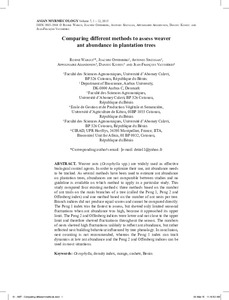| dc.contributor.author | Wargui, R. |
| dc.contributor.author | Offenberg, J. |
| dc.contributor.author | Sinzogan, A.A.C. |
| dc.contributor.author | Adandonon, A. |
| dc.contributor.author | Kossou, D. |
| dc.contributor.author | Vayssières, J.F. |
| dc.date.accessioned | 2019-12-04T10:58:07Z |
| dc.date.available | 2019-12-04T10:58:07Z |
| dc.date.issued | 2015 |
| dc.identifier.citation | Wargui, R., Offenberg, J., Sinzogan, A., Adandonon, A., Kossou, D., & Vayssières, J.F. (2015). Comparing different methods to assess weaver ant abundance in plantation trees. Asian Myrmecology. |
| dc.identifier.issn | 1985-1944 |
| dc.identifier.uri | https://hdl.handle.net/20.500.12478/919 |
| dc.description.abstract | Weaver ants (Oecophylla spp.) are widely used as effective biological control agents. In order to optimize their use, ant abundance needs to be tracked. As several methods have been used to estimate ant abundance on plantation trees, abundances are not comparable between studies and no guideline is available on which method to apply in a particular study. This study compared four existing methods: three methods based on the number of ant trails on the main branches of a tree (called the Peng 1, Peng 2 and Offenberg index) and one method based on the number of ant nests per tree. Branch indices did not produce equal scores and cannot be compared directly. The Peng 1 index was the fastest to assess, but showed only limited seasonal fluctuations when ant abundance was high, because it approached its upper limit. The Peng 2 and Offenberg indices were lower and not close to the upper limit and therefore showed fluctuations throughout the season. The numbers of nests showed high fluctuations unlikely to reflect ant abundance, but rather reflected nest building behaviour influenced by tree phenology. In conclusion, nest counting is not recommended, whereas the Peng 1 index can track dynamics at low ant abundance and the Peng 2 and Offenberg indices can be used in most situations. |
| dc.language.iso | en |
| dc.subject | Oecophylla |
| dc.subject | Mangoes |
| dc.subject | Cashew |
| dc.title | Comparing different methods to assess weaver ant abundance in plantation trees |
| dc.type | Journal Article |
| dc.description.version | Peer Review |
| cg.contributor.affiliation | Université d'Abomey Calavi |
| cg.contributor.affiliation | Aarhus University |
| cg.contributor.affiliation | Université d'Agriculture de Kétou |
| cg.contributor.affiliation | Centre de Coopération Internationale en Recherche Agronomique pour le Développement |
| cg.contributor.affiliation | Centre de Coopération Internationale en Recherche Agronomique pour le Développement |
| cg.contributor.affiliation | Centre de Coopération Internationale en Recherche Agronomique pour le Développement |
| cg.contributor.affiliation | International Institute of Tropical Agriculture |
| cg.contributor.affiliation | Centre de Coopération Internationale en Recherche Agronomique pour le Développement |
| cg.coverage.region | Africa |
| cg.coverage.region | West Africa |
| cg.coverage.country | Benin |
| cg.isijournal | ISI Journal |
| cg.authorship.types | CGIAR multi-centre |
| cg.journal | Asian Myrmecology |
| cg.howpublished | Formally Published |
| cg.accessibilitystatus | Limited Access |
| local.dspaceid | 76418 |

